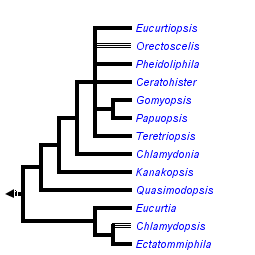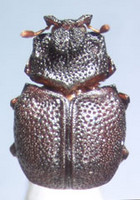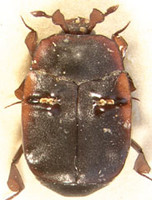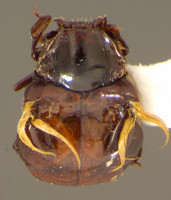Chlamydopsinae
Michael S. Caterino


This tree diagram shows the relationships between several groups of organisms.
The root of the current tree connects the organisms featured in this tree to their containing group and the rest of the Tree of Life. The basal branching point in the tree represents the ancestor of the other groups in the tree. This ancestor diversified over time into several descendent subgroups, which are represented as internal nodes and terminal taxa to the right.

You can click on the root to travel down the Tree of Life all the way to the root of all Life, and you can click on the names of descendent subgroups to travel up the Tree of Life all the way to individual species.
For more information on ToL tree formatting, please see Interpreting the Tree or Classification. To learn more about phylogenetic trees, please visit our Phylogenetic Biology pages.
close boxIntroduction
The Chlamydopsinae is one of two exclusively inquilinous subfamilies of Histeridae (along with Hetaeriinae). Until recently this was probably the most poorly known of all histerid groups, but it has received some important recent attention (Caterino, 2000; Dégallier & Caterino, 2005a, b; Caterino & Dégallier, 2007). Chlamydopsinae are rather restricted in distribution. Most of the described species are Australian, although additional species have been described from India, Japan, Taiwan, Fiji, New Caledonia, Indonesia, and Malaysia. It is likely that many new species remain be found throughout mainland and insular southeast Asia.
Characteristics
The main synapomorphy of the subfamily is also its best diagnostic character: the antennal scape is inserted high on the frons, above the eye, and is expanded such that it completely hides the eye when the head is withdrawn (the name Chlamydopsis means ‘covered eye’).
Most species have trichomes, or exaggerated secretory structures, on the front corners of the elytra, associated with their inquilinous habits. A few species have lost these structures, and in some they are present on the prothorax.
Discussion of Phylogenetic Relationships
Relationships within Chlamydopsinae have been difficult to resolve, in large part because of the rarity of the species. Pheidoliphila, Orectoscelis, Ceratohister, Eucurtiopsis, Teretriopsis, Papuopsis and Gomyopsis together clearly form a monophyletic group. In all of these the scutellum is hidden by the posterior margin of the pronotum, a strong synapomorphy. Two recently discovered genera from New Caledona, Kanakopsis and Chlamydonia (Caterino, 2006) appear transitional in this regard.
The newly described Quasimodopsis (Caterino & Dégallier, 2007) also has the scutellum hidden, though in this case by the pronotum rather than the bases of the elytra. According to recent analyses this does appear to be the sister group of the remaining 'hidden scutellum' lineage.
Analyses to date place the remaining genera, Chlamydopsis, Eucurtia and Ectatommiphila, as the sister group of all of the above. Given the size and primitive state of knowledge especially of Chlamydopsis, this hypothesis requires further testing.
References
Caterino, M. S. 2000. Descriptions of the first Chlamydopsinae (Coleoptera: Histeridae) from Wallacea. Tijdschrift voor Entomologie 143:267-278.
Caterino, M. S. 2006. Chlamydopsinae from New Caledonia. Memoirs of the Queensland Museum 52:27–64.
Caterino. M. S. and Dégallier, N. 2007. A review of the biology and systematics of Chlamydopsinae. Invertebrate Systematics 21:1-28.
Dégallier, N. 1984. Gomyopsis kuscheli, nouveau genre et nouvelle espece de Chlamydopsinae. Nouvelle Revue Entomologie (N. S.) 1:55-59.
Dégallier, N., and Caterino, M. S. 2005a. Notes taxonomiques sur les Chlamydopsinae et descriptions d’espèces nouvelles. - I. Genres Ceratohister Reichensperger, Eucurtiopsis Silvestri et Orectoscelis Lewis. Bulletin de la Societe Entomologique de France 110:299–326.
Dégallier, N., and Caterino, M. S. 2005b. Notes taxonomiques sur les Chlamydopsinae et descriptions d’espèces nouvelles. - II. Genre Pheidoliphila Lea. Bulletin de la Societe Entomologique de France 110:463–494.
Lea, A. 1912. Australian and Tasmanian Coleoptera. Proceedings of the Royal Society of Victoria 25: 31-78.
Nishikawa, M. 1996. On the genus Eucurtiopsis Silvestri occurring in Japan and Taiwan. Kanagawa-Chuho, Odawara 113:7-11.
Nishikawa, M., and K. Maruyama. 1993. Coleoptera in Zama-shi, Kanagawa pref.:219-308.
Oke, C. 1923. Notes on the Victorian Chlamydopsinae, with descriptions of new species. Victorian Naturalist 49:152-162.
Sawada, K. 1991. New myrmecophilous Coleoptera in Nepal and Japan. Contributions of the Biological Laboratory of Kyoto University 28:357-365.
Information on the Internet
- Lucid Key to the Genera of Chlamydopsinae (Beta version). This site presents an interactive Lucid key to all known Chlamydopsine genera. Most characters, and all taxa are illustrated.
- Color images of species. Supplements to descriptive papers on Chlamydopsis, Pheidoliphila, Orectoscelis, Eucurtiopsis, Ceratohister and Chlamydonia.
Title Illustrations

| Scientific Name | Ceratohister ankylonotum |
|---|---|
| Location | Sabah, Malaysia |
| Specimen Condition | Dead Specimen |
| Identified By | Michael S. Caterino |
| Image Use |
 This media file is licensed under the Creative Commons Attribution-ShareAlike License - Version 3.0. This media file is licensed under the Creative Commons Attribution-ShareAlike License - Version 3.0.
|
| Copyright |
© 2002

|
| Scientific Name | Ectatommiphila opaca |
|---|---|
| Location | Australia |
| Specimen Condition | Dead Specimen |
| Image Use |
 This media file is licensed under the Creative Commons Attribution-ShareAlike License - Version 3.0. This media file is licensed under the Creative Commons Attribution-ShareAlike License - Version 3.0.
|
| Copyright |
© 2002

|
| Scientific Name | Eucurtia comata |
|---|---|
| Specimen Condition | Dead Specimen |
| Identified By | Michael S. Caterino |
| View | dorsal |
| Collection | The Natural History Museum, London |
| Type | Holotype |
| Image Use |
 This media file is licensed under the Creative Commons Attribution-ShareAlike License - Version 3.0. This media file is licensed under the Creative Commons Attribution-ShareAlike License - Version 3.0.
|
| Copyright |
©

|
About This Page
Acknowledgments: Much of the current work on Chlamydopsinae has been carried out in collaboration with Nicolas Degallier. Most of the uncited ideas presented above derive from our discussions. Numerous collectors and collection managers have provided us with tremendous help and wonderful specimens over the past couple years of chlamydopsine work, especially Ross Storey, Geoff Monteith, Tom Weir, Eric Matthews, Terry Houston, Alexander Reidel, and Bob Anderson. Keep ‘em coming, guys!

Santa Barbara Museum of Natural History, Santa Barbara, California, USA
Page copyright © 2002
 Page: Tree of Life
Chlamydopsinae.
Authored by
Michael S. Caterino.
The TEXT of this page is licensed under the
Creative Commons Attribution License - Version 3.0. Note that images and other media
featured on this page are each governed by their own license, and they may or may not be available
for reuse. Click on an image or a media link to access the media data window, which provides the
relevant licensing information. For the general terms and conditions of ToL material reuse and
redistribution, please see the Tree of Life Copyright
Policies.
Page: Tree of Life
Chlamydopsinae.
Authored by
Michael S. Caterino.
The TEXT of this page is licensed under the
Creative Commons Attribution License - Version 3.0. Note that images and other media
featured on this page are each governed by their own license, and they may or may not be available
for reuse. Click on an image or a media link to access the media data window, which provides the
relevant licensing information. For the general terms and conditions of ToL material reuse and
redistribution, please see the Tree of Life Copyright
Policies.
- First online 07 March 2002
- Content changed 15 July 2007
Citing this page:
Caterino, Michael S. 2007. Chlamydopsinae. Version 15 July 2007 (under construction). http://tolweb.org/Chlamydopsinae/9386/2007.07.15 in The Tree of Life Web Project, http://tolweb.org/











 Go to quick links
Go to quick search
Go to navigation for this section of the ToL site
Go to detailed links for the ToL site
Go to quick links
Go to quick search
Go to navigation for this section of the ToL site
Go to detailed links for the ToL site